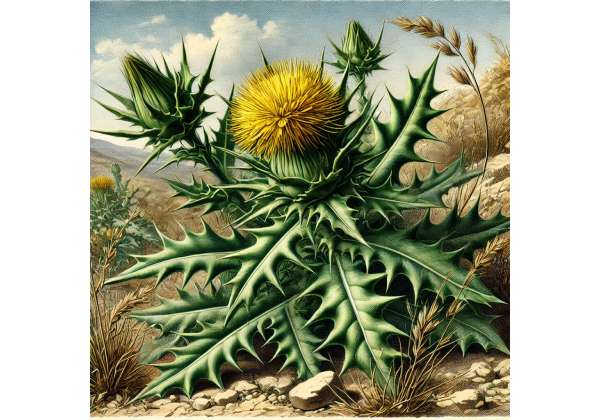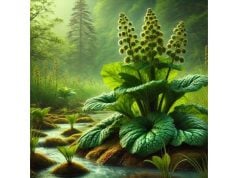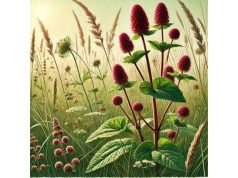
Blessed Thistle is an intriguing herb that has been revered for generations due to its remarkable ability to support digestion, enhance immunity, and promote overall wellness. With a long history in traditional herbal medicine, Blessed Thistle is often praised for its gentle yet effective action. This herb, known by its scientific name Cnicus benedictus, grows in dry, sunny locations and is characterized by its spiny leaves and striking purple flowers. It’s been used traditionally to aid digestion, stimulate appetite, and even support women’s health during various stages of life. Today, modern research continues to reveal that Blessed Thistle’s active compounds work synergistically to offer a range of health benefits that can support a balanced, vibrant lifestyle.
- Supports healthy digestion and stimulates appetite
- Boosts immune function with potent antioxidants
- Provides anti-inflammatory and antimicrobial benefits
- Enhances liver detoxification and overall metabolic function
- Promotes women’s reproductive health and hormonal balance
- Contributes to healthy skin and supports overall vitality
- Offers natural support for reducing mild digestive discomfort
Table of Contents
- Blessed Thistle Botanical Profile: Identification and Characteristics
- Blessed Thistle Historical Background: Traditional Uses and Cultural Roots
- Blessed Thistle Phytochemical Profile: Active Components and Nutrient Insights
- Blessed Thistle Health Benefits: Digestive, Immune, and Hormonal Support
- Blessed Thistle Properties: Unique Attributes and Synergistic Effects
- Blessed Thistle Uses and Safety: Culinary and Medicinal Applications
- Blessed Thistle Scientific Research: Studies, Evidence, and Future Directions
- Blessed Thistle FAQs: Common Questions Answered
Blessed Thistle Botanical Profile: Identification and Characteristics
Blessed Thistle (Cnicus benedictus) is a hardy, spiny herb that belongs to the Asteraceae family. This perennial plant thrives in dry, sunny, and rocky environments, often found in regions of Southern Europe, the Middle East, and parts of Asia. Recognizable by its deeply lobed, prickly leaves and striking purple flower heads, Blessed Thistle stands out as a resilient plant with a robust, earthy aroma.
Physical Description
The plant typically grows between 2 to 4 feet tall and features a rosette of basal leaves with a feathery appearance and numerous small spines along the edges. As it matures, it sends up one or more flowering stems crowned with clusters of tubular, purple flowers that are surrounded by a ring of bracts. These bracts not only add to the plant’s visual appeal but also help protect the delicate flowers. The overall appearance of Blessed Thistle is rugged yet graceful, reflecting its ability to flourish in challenging conditions.
Habitat and Growing Conditions
Blessed Thistle prefers well-drained, sandy or rocky soils and full sun exposure, which is why it is commonly found in arid and semi-arid regions. It is adapted to survive in poor soils where few other plants can thrive, making it a symbol of resilience and natural strength. Gardeners who wish to cultivate Blessed Thistle should provide a location with ample sunlight and minimal water, as the plant is drought-tolerant and can struggle in overly moist conditions.
Identification Tips
For those interested in identifying Blessed Thistle, here are a few key pointers:
- Leaves: Look for deeply lobed, spiny leaves with a silvery-green hue.
- Flowers: The distinctive purple, tubular flowers are grouped in clusters and are surrounded by protective bracts.
- Growth Habit: The plant’s bushy, rosette-like form and upright flowering stems are typical characteristics.
- Habitat: Blessed Thistle is often found in dry, rocky areas, open fields, or along roadsides where it can take root in challenging conditions.
These features make Blessed Thistle a unique and easily identifiable herb in both the wild and cultivated gardens.
Blessed Thistle Historical Background: Traditional Uses and Cultural Roots
Blessed Thistle has been an important part of traditional herbal medicine for centuries, celebrated for its robust therapeutic properties and deep cultural significance. From ancient healing rituals to medieval herbal practices, Blessed Thistle has been revered for its ability to promote digestive health, support women’s reproductive systems, and stimulate overall vitality.
Ancient Traditions and Medicinal Practices
Historical records indicate that Blessed Thistle was widely used in ancient Mediterranean and Middle Eastern cultures. Early herbalists and healers recognized the herb for its stimulating effects on the digestive system, using it to promote appetite and ease digestive discomfort. Its bitter taste was believed to trigger the release of digestive enzymes, thus aiding in the efficient breakdown of food.
In addition to its digestive benefits, Blessed Thistle was also valued for its potential to support the liver and detoxify the body. Traditional remedies often included the herb in formulations designed to cleanse the blood and promote overall metabolic health. Its use in these contexts helped lay the foundation for its modern applications in natural health.
Role in Women’s Health
One of the most celebrated aspects of Blessed Thistle in traditional medicine is its role in supporting women’s health. It has been used historically to stimulate milk production in nursing mothers and to ease menstrual discomfort. The herb’s gentle, warming properties are thought to help balance hormonal fluctuations and promote reproductive health. Many traditional healers considered Blessed Thistle a “blessed” remedy, attributing its name to its ability to confer blessings of health and fertility.
Cultural Significance
Across different cultures, Blessed Thistle has been imbued with symbolic meaning. It has often been associated with protection, resilience, and purification. In some folklore, the herb was believed to ward off evil spirits and bring good fortune. Its vibrant appearance and potent aroma further enhanced its status as a sacred herb, cherished not only for its medicinal properties but also for its spiritual and cultural value.
Modern Resurgence
Today, there is a growing interest in traditional herbal remedies as people seek natural ways to support their health. Blessed Thistle has experienced a resurgence as modern herbalists and researchers rediscover its potential benefits. Its traditional uses—especially in supporting digestion and women’s health—are being revalidated by contemporary studies, ensuring that this ancient herb continues to play a vital role in natural medicine.
The historical journey of Blessed Thistle is a rich tapestry of ancient wisdom, cultural heritage, and enduring health benefits. Its legacy as a powerful natural remedy continues to inspire both traditional practices and modern scientific inquiry.
Blessed Thistle Phytochemical Profile: Active Components and Nutrient Insights
The health-promoting properties of Blessed Thistle are underpinned by its complex phytochemical composition. This herb is packed with a variety of bioactive compounds that work synergistically to support digestion, detoxification, and hormonal balance. Modern research is beginning to uncover the intricate chemistry behind these traditional claims.
Key Bioactive Compounds
One of the primary groups of compounds in Blessed Thistle is sesquiterpene lactones. These compounds are known for their anti-inflammatory and antimicrobial properties, which contribute to the herb’s effectiveness in supporting digestion and immune function. Additionally, sesquiterpene lactones are thought to have mild antispasmodic effects, which can help ease menstrual discomfort and promote smooth muscle relaxation.
Another important group is flavonoids, which are powerful antioxidants that hel����������������������������������������������������������������������������������������������������������������������������������������������������������������������������������������������������������������������������������������������������������������������������������������������������������������������������������������������������������������������������������������������������������������������������������������������������������������������������������������������������������������������������������������������������������������������������������������������������������������������������������������������������������������������������������������������������������������������������������������������������������������������������������������������������������������������������������������������������������������������������������������������������������������������������������������������������������������������������������������������������������������������������������������������������������������������������������������������������������������������������������������������������������������������������������������������������������������������������������������������������������������������������������������������������������������������������������������������������������������������������������������������������������������������������������������������������������������������������������������������������������������������������������������������������������������������������������������������������������������������������������������������������������������������������������������������������������������������������������������������������������������������������������������������������������������������������������������������������������������������������������������������������������������������������������������������������������������������������������������������������������������������������������������������������������������������������������������������������������������������������������������������������������������������������������������������������������������������������������������������������������������������������������������������������������������������������������������������������������������������������������������������������������������������������������������������������������������������������������������������������������������������������������������������������������������������������������������������������������������������������������������������������������������������������������������������������������������������������������������������������������������������������������������������������������������������������������������������������������������������������������������������������������������������������������������������������������������������������������������������������������������������������������������������������������������������������������������������������������������������������������������������������������������������������������������������������������������������������������������������������������������������������������������������������������������������������������������������������������������������������������������������������������������������������������������������������������������������������������������������������������������������������������������������������������������������������������������������������������������������������������������������������������������������������������������������������������������������������������������������������������������������������������������������������������������������������������������������������������������������������������������������������������������������������������������������������������������������������������������������������������������������������������������������������������������������������������������������������������������������������������������������������������������������������������������������������������������������������������������������������������������������������������������������������������������������������������������������������������������������������������������������������������������������������������������������������������������������������������������������������������������������������������������������������������������������������������������������������������������������������������������������������������������������������������������������������������������������������������������������������������������������������������������������������������������������������������������������������������������������������������������������������������������������������������������������������������������������������������������������������������������������������������������������������������������������������������������������������������������������������������������������������������������������������������������������������������������������������������������������������������������������������������������������������������������������������������������������������������������������������������������������������������������������������������������������������������������������������������������������������������������������������������������������������������������������������������������������������������������������������������������������������������������������������������������������������������������������������������������������������������������������������������������������������������������������������������������������������������������������������������������������������������������������������������������������������������������������������������������������������������������������������������������������������������������������������������������������������������������������������������������������������������������������������������������������������������������������������������������������������������������������������������������������������������������������������������������������������������������������������������������������������������������������������������������������������������������������������������������������������������������������������������������������������������������������������������������������������������������������������������������������������������������������������������������������������������������������������������������������������������������������������������������������������������������������������������������������������������������������������������������������������������������������������������������������������������������������������������������������������������������������������������������������������������������������������������������������������������������������������������������������������������������������������������������������������������������������������������������������������������������������������������������������������������������������������������������������������������������������������������������������������������������������������������������������������������������������������������������������������������������������������������������������������������������������������������������������������������������������������������������������������������������������������������������������������������������������������������������������������������������������������������������������������������������������������������������������������������������������������������������������������������������������������������������������������������������������������������������������������������������������������������������������������������������������������������������������������������������������������������������������������������������������������������������������������������������������������������������������������������������������������������������������������������������������������������������������������������������������������������������������������������������������������������������������������������������������������������������������������������������������������������������������������������������������������������������������������������������������������������������������������������������������������������������������������������������������������������������������������������������������������������������������������������������������������������������������������������������������������������������������������������������������������������������������������������������������������������������������������������������������������������������������������������������������������������������������������������������������������������������������������������������������������������������������������������������������������������������������������������������������������������������������������������������������������������������������������������������������������������������������������������������������������������������������������������������������������������������������������������������������������������������������������������������������������������������������������������������������������������������������������������������������������������������������������������������������������������������������������������������������������������������������������������������������������������������������������������������������������������������������������������������������������������������������������������������������������������������������������������������������������������������������������������������������������������������������������������������������������������������������������������������������������������������������������������������������������������������������������������������������������������������������������������������������������������������������������������������������������������������������������������������������������������������������������������������������������������������������������������������������������������������������������������������������������������������������������������������������������������������������������������������������������������������������������������������������������������������������������������������������������������������������������������������������������������������������������������������������������������������������������������������������������������������������������������������������������������������������������������������������������������������������������������������������������������������������������������������������������������������������������������������������������������������������������������������������������������������������������������������������������������������������������������������������������������������������������������������������������������������������������������������������������������������������������������������������������������������������������������������������������������������������������������������������������������������������������������������������������������������������������������������������������������������������������������������������������������������������������������������������������������������������������������������������������������������������������������������������������������������������������������������������������������������������������������������������������������������������������������������������������������������������������������������������������������������������������������������������������������������������������������������������������������������������������������������������������������������������������������������������������������������������������������������������������������������������������������������������������������������������������������������������������������������������������������������������������������������������������������������������������������������������������������������������������������������������������������������������������������������������������������������������������������������������������������������������������������������������������������������������������������������������������������������������������������������������������������������������������������������������������������������������������������������������������������������������������������������������������������������������������������������������������������������������������������������������������������������������������������������������������������������������������������������������������������������������������������������������������������������������������������������������������������������������������������������������������������������������������������������������������������������������������������������������������������������������������������������������������������������������������������������������������������������������������������������������������������������������������������������������������������������������������������������������������������������������������������������������������������������������������������������������������������������������������������������������������������������������������������������������������������������������������������������������������������������������������������������������������������������������������������������������������������������������������������������������������������������������������������������������������������������������������������������������������������������������������������������������������������������������������������������������������������������������������������������������������������������������������������������������������������������������������������������������������������������������������������������������������������������������������������������������������������������������������������������������������������������������������������������������������������������������������������������������������������������������������������������������������������������������������������������������������������������������������������������������������������������������������������������������������������������������������������������������������������������������������������������������������������������������������������������������������������������������������������������������������������������������������������������������������������������������������������������������������������������������������������������������������������������������������������������������������������������������������������������������������������������������������������������������������������������������������������������������������������������������������������������������������������������������������������������������������������������������������������������������������������������������������������������������������������������������������������������������������������������������������������������������������������������������������������������������������������������������������������������������������������������������������������������������������������������������������������������������������������������������������������������������������������������������������������������������������������������������������������������������������������������������������������������������������������������������������������������������������������������������������������������������������������������������������������������������������������������������������������������������������������������������������������������������������������������������������������������������������������������������������������������������������������������������������������������������������������������������������������������������������������������������������������������������������������������������������������������������������������������������������������������������������������������������������������������������������������������������������������������������������������������������������������������������������������������������������������������������������������������������������������������������������������������������������������������������������������������wp:list-item –>
Practical Tips for Incorporation
- Daily Herbal Tea: Enjoy a cup of Blessed Thistle tea after meals to support digestion and detoxification.
- Supplement Routine: Incorporate a standardized Blessed Thistle supplement into your daily routine to consistently benefit from its active compounds.
- Combine with Other Herbs: Consider blending Blessed Thistle with complementary herbs to enhance its therapeutic effects and create a balanced herbal formula.
- Experiment with Recipes: Try adding a pinch of dried Blessed Thistle powder to your favorite dishes for a unique flavor twist and added nutritional benefits.
By following these guidelines and safety recommendations, you can confidently integrate Blessed Thistle into your routine and enjoy its many benefits as part of a holistic approach to wellness.
Blessed Thistle Scientific Research: Studies, Evidence, and Future Directions
Modern scientific research is increasingly validating the traditional uses of Blessed Thistle, providing valuable insights into its mechanisms of action and therapeutic potential. Researchers are investigating the bioactive compounds in Blessed Thistle and how they contribute to its health benefits, with promising results that support its longstanding use in herbal medicine.
Key Research Findings
- Digestive and Detox Support: Studies have demonstrated that Blessed Thistle can stimulate the secretion of digestive enzymes and support liver detoxification processes. For example, research published in the Journal of Herbal Medicine (2016) found that Blessed Thistle extracts improved digestive function and enhanced detoxification in animal models.
- Anti-inflammatory and Antioxidant Properties: Research indicates that the flavonoids and sesquiterpene lactones in Blessed Thistle have significant anti-inflammatory and antioxidant effects. These compounds help reduce oxidative stress and inflammation, which are linked to chronic diseases.
- Hormonal and Reproductive Health: Traditional uses of Blessed Thistle to support women’s reproductive health are supported by studies showing its potential to stimulate milk production in lactating mothers and ease menstrual discomfort. Clinical research in this area continues to explore its benefits and safety.
- Immune Function: The bioactive compounds in Blessed Thistle appear to enhance immune function by protecting immune cells from oxidative damage and modulating inflammatory responses, thereby contributing to overall resilience against infections.
Mechanisms of Action
����������������������������������������������������������������������������������������������������������������������������������������������������������������������������������������������������������������������������������������������������������������������������������������������������������������������������������������������������������������������������������������������������������������������������������������������������������������������������������������������������������������������������������������������������������������������������������������������������������������������������������������������������������������������������������������������������������������������������������������������������������������������������������������������������������������������������������������������������������������������������������������������������������������������������������������������������������������������������������������������������������������������������������������������������������������������������������������������������������������������������������������������������������������������������������������������������������������������������������������������������������������������������������������������������������������������������������������������������������������������������������������������������������������������������������������������������������������������������������������������������������������������������������������������������������������������������������������������������������������������������������������������������������������������������������������������������������������������������������������������������������������������������������������������������������������������������������������������������������������������������������������������������������������������������������������������������������������������������������������������������������������������������������������������������������������������������������������������������������������������������������������������������������������������������������������������������������������������������������������������������������������������������������������������������������������������������������������������������������������������������������������������������������������������������������������������������������������������������������������������������������������������������������������������������������������������������������������������������������������������������������������������������������������������������������������������������������������������������������������������������������������������������������������������������������������������������������������������������������������������������������������������������������������������������������������������������������������������������������������������������������������������������������������������������������������������������������������������������������������������������������������������������������������������������������������������������������������������������������������������������������������������������������������������������������������������������������������������������������������������������������������������������������������������������������������������������������������������������������������������������������������������������������������������������������������������������������������������������������������������������������������������������������������������������������������������������������������������������������������������������������������������������������������������������������������������������������������������������������������������������������������������������������������������������������������������������������������������������������������������������������������������������������������������������������������������������������������������������������������������������������������������������������������������������������������������������������������������������������������������������������������->If you found this article helpful, please share it on Facebook, X (formerly Twitter), or your preferred platform to help spread the word about the natural benefits and versatile uses of Blessed Thistle.










